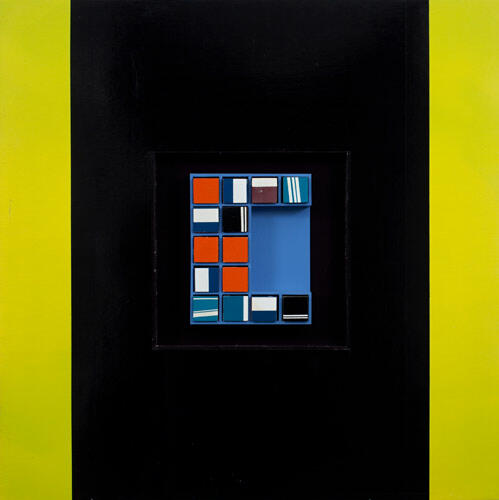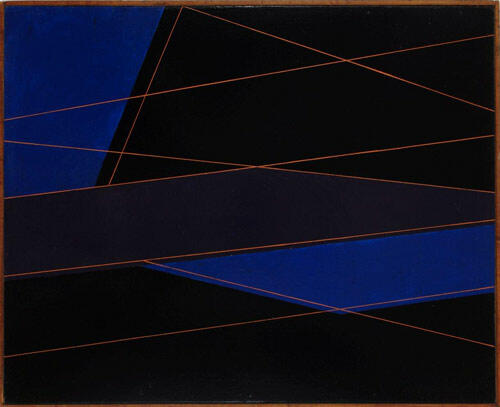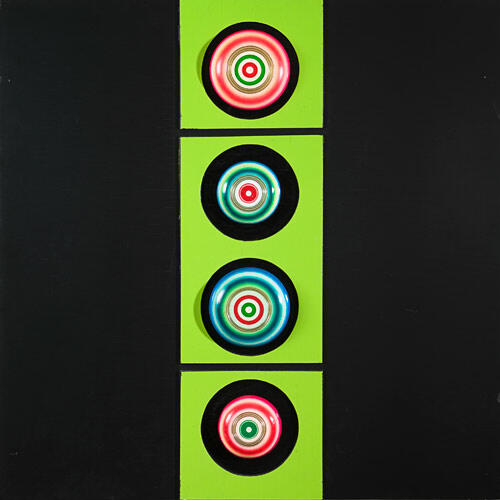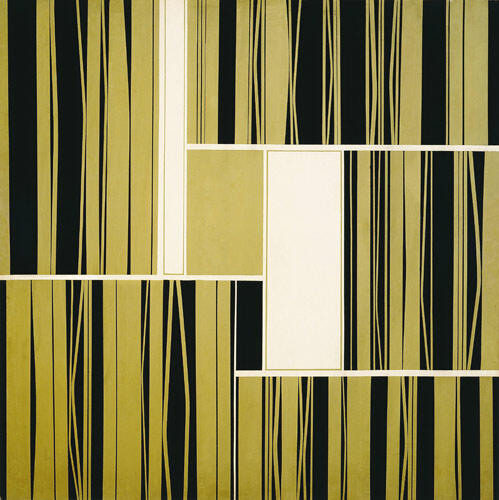Omar Carreño
An Assembly Kit
The capacity for transformation that may be perceived in Omar Carreño’s works reveals, right from the start, the Utopian dream of any artist: that of being able to create a new order for the world. Such was the promise inherent in abstractionism in the 1950s and 1960s, when the proposal of the Venezuelan artist and his kinetic colleagues was to abandon the conventional rendering of landscapes and characters in order to exert a direct influence on them through art integrated into architecture, through works including elements that could be moved, touched, turned in different directions and reassembled like a LEGO toy; and even through games involving visual perception that forced the viewer to become involved with the work.

More than half a century has gone by, but the promise is still valid. It may be glimpsed in the different compositional solutions that Carreño utilizes on the canvas, as well as on walls and in the space in general. The plane sequences are repeated without becoming boring, incorporating the necessary element of rhythm and, of course, of movement.
In the early stages of his career as an abstract painter, Carreño’s compositional patterns were extremely well organized; later, with a little freedom from that impression of exact and reticular calculation, his work adopted other guidelines, although in no way may the artist be branded chaotic in the handling of space.
At the beginning, he talked about the fight which had to be put up in the field of art. “I am referring to a fight between new ways of life and new forms of art against the obsolete ways and forms of the past. Wherever there are conflicting trends, or the need for compatibility is raised, art is deprived of a current of vitality,” the artist declared in the 1960s, in an article for El Nacional.
Faithful to those postulates, only many years later did he dare to show his figurative early works, featured in an exhibition hosted by Boggie gallery in 1980; he repeated the experience in the exhibition Todas las presencias, staged by Durban Segnini Gallery, Caracas, in 1989.
He continued cultivating representational art, eventually composing his series Veleros (Sailboats), but always privileging the elements of visual expression over the narrative, or over anecdote. Where the rest of humanity sees things − such as ships, for example − Carreño perceives lines, planes, contrasts. “The theme, the object becomes unimportant. It is more important to organize, to compose. I only take that which is essential in the object,” he stated on that occasion in El Nacional.
Although he was able to dispense with figuration, as an artist trained in the School of Fine Arts in Caracas he could not avoid the concern of landscape painters regarding light. Together with color, light continued to be a problem in terms of its visual handling. He approached it through the incorporation of artificial light in his creations, in the framework of research work developed between 1967 and 1978, an investigation which faced its acid test in the 1972 Venice Biennial. The artist was selected to represent Venezuela with a series of transformable luminous works which, together, gave shape to a large three-room mansion.
By then, Carreño had already been living in Paris. There he produced his first transformable works, structures held together by hinges that allowed the spectators to alter and rearrange them. The concept combined the notions of picture-object and sculpture. These works, known as Polyptics, were shown for the first time in 1953 at Arnaud Gallery, where he began to lay the foundations for Expansionism.
Carreño became associated with important artistic groups of the time, such as “Los Disidentes” and the MADI Group, headed by the Uruguayan artist Carmelo Arden Quin. Five years before his participation in the Venice Biennial, more specifically in 1967, he had been the creator of Expansionism, a movement linked to Constructivism, which advocated the adoption of transformable pieces allowing the expansion of the role of the viewer from passive contemplation to an increasingly active interaction with the artwork, and opening new paths for a genuine communication between artists and audiences. Such the definition of Perán Erminy on the occasion of the exhibition celebrating the 40th anniversary of the Manifesto of the movement promoted by Carreño in 1967, and featuring the artist’s transformable three-dimensional works composed of cubes with their faces painted in different colors, which allowed an almost infinite number of combinations.
The mentioned exhibition, entitled Expansionismo, was held at the Omar Carreño Art Center in Porlamar, Margarita Island. Curated by Carreño himself and by Luis Miguel Molina, this show gathered together the work of the Brazilian artists Jaildo Marinho and Gonçalo Ivo, the Ecuadorean Hernán Jara, the Colombian Jorge Jaramillo, the Chilean Iván Contreras-Brunet, and from Venezuela, Arturo Millán, Inés Silva, Luis Millè, Jesús Salvador Rodríguez, the already mentioned Erminy, Nanín, Alirio Oramas, William Barbosa, Daniel Velásquez, Ángel Hernández, Luis Arnal, Octavio Herrera, Iván Rojas and, of course, Carreño. The show also included the participation of several European artists, such as the Hungarian István Ezsiás, the Italians Renato Milo, Saverio Cecere, and Marta Pilone, the German Wolfgang Ulbrich and the French artists Nicole Guyhart, Ania Borzobohaty, and Claude Bourguignon.
Showing the resonance that this movement continues to have at the international level has probably been one of the most recent landmarks in Carreño’s trajectory, as has also the exhibition that Henrique Faría Fine Art is dedicating in New York to his work of the 1950’s and 1960s.
In some of the pieces featured in this exhibit, neon colors are highlighted as protagonists, as pure expressive elements. More outstanding in others are the combinations of planes suggesting other dimensions of time and space.
Contrasting both exhibitions, the viewer reaches the conclusion that Carreño is not only an artist interested in science and concerned with the aesthetic and social problems of his time, but that he is also a researcher of light, space and color; a person who has devoted his 84 years of existence to seek the best way to communicate with the numerous pairs of eyes that have viewed his work in America and Europe.
Profile
Omar Carreño was born in Porlamar on February 7, 1927. He replaced the sunsets in the island with the classrooms of the School of Fine Arts in Caracas, where he was admitted in 1948. There he participated in several salons, featuring markedly figurative proposals. In 1949 he started frequenting the Taller Libre de Arte, where he came face to face with abstractionism and had his first solo show. A year later he traveled to Paris, France, which enabled him to present one-person exhibitions and participate in group shows. On his return to Venezuela, he collaborated with Carlos Raúl Villanueva in the Project for the University Campus. In 1972 he represented Venezuela in the Venice Biennial and was the recipient of the National Fine Arts Award. A year later he was the winner of the First Prize at the Michelena Salon. He has had over fifty solo shows.
-
 Transformable 24, 1967. Lacquer on wood, 37 ¼ x 37 ¼ in. Courtesy Henrique Faria Fine Art. Transformable 24, 1967. Laca sobre madera, 95,3 x 95,3 cm. Cortesía Henrique Faria Fine Art.
Transformable 24, 1967. Lacquer on wood, 37 ¼ x 37 ¼ in. Courtesy Henrique Faria Fine Art. Transformable 24, 1967. Laca sobre madera, 95,3 x 95,3 cm. Cortesía Henrique Faria Fine Art.
-
 Dos Azules, 1953. Ripolin on wood, 18 x 22 in. Courtesy Henrique Faria Fine Art. Dos Azules, 1953. Ripolin sobre madera, 45,7 x 56 cm. Cortesía Henrique Faria Fine Art.
Dos Azules, 1953. Ripolin on wood, 18 x 22 in. Courtesy Henrique Faria Fine Art. Dos Azules, 1953. Ripolin sobre madera, 45,7 x 56 cm. Cortesía Henrique Faria Fine Art. -
 Expansión II, 1967. Lacquer on wood, 24 ¾ x 24 ¾ in. Courtesy Henrique Faria Fine Art. Expansión II, 1967. Laca sobre Madera, 63 x 63 cm. Cortesía Henrique Faria Fine Art.
Expansión II, 1967. Lacquer on wood, 24 ¾ x 24 ¾ in. Courtesy Henrique Faria Fine Art. Expansión II, 1967. Laca sobre Madera, 63 x 63 cm. Cortesía Henrique Faria Fine Art. -
 Transformable 11, 1967. Lacquer on wood, 37 ¼ x 37 ¼ in. Courtesy Henrique Faria Fine Art. Transformable 11, 1967. Laca sobre madera, 95,3 x 95,3 cm. Cortesía Henrique Faria Fine Art.
Transformable 11, 1967. Lacquer on wood, 37 ¼ x 37 ¼ in. Courtesy Henrique Faria Fine Art. Transformable 11, 1967. Laca sobre madera, 95,3 x 95,3 cm. Cortesía Henrique Faria Fine Art. -
 Posinega, 1957. Lacquer on wood, 39.4 x 39.4 in. Courtesy Colección Mercantil, Caracas. Photo: Reinaldo Armas. Posinega, 1957. Laca sobre madera, 100 x 100 cm. Cortesía: Colección Mercantil, Caracas. Fotografía: Reinaldo Armas.
Posinega, 1957. Lacquer on wood, 39.4 x 39.4 in. Courtesy Colección Mercantil, Caracas. Photo: Reinaldo Armas. Posinega, 1957. Laca sobre madera, 100 x 100 cm. Cortesía: Colección Mercantil, Caracas. Fotografía: Reinaldo Armas. -
 Tablón n°2, 1957. Lacquer on wood, 39.4 x 39.4 in. Courtesy Colección Mercantil, Caracas. Photo: Reinaldo Armas. Tablón n°2, 1957. Laca sobre madera, 100 x 100 cm. Cortesía: Colección Mercantil, Caracas. Fotografía: Reinaldo Armas.
Tablón n°2, 1957. Lacquer on wood, 39.4 x 39.4 in. Courtesy Colección Mercantil, Caracas. Photo: Reinaldo Armas. Tablón n°2, 1957. Laca sobre madera, 100 x 100 cm. Cortesía: Colección Mercantil, Caracas. Fotografía: Reinaldo Armas. -
 Untitled, 1964. Pigments on cardboard. 12.4 x 9.4 in. Courtesy Colección Mercantil, Caracas. Photo: Reinaldo Armas. Sin título, 1964. Pigmentos sobre cartón, 31,7 x 24 cm. Cortesía: Colección Mercantil, Caracas. Fotografía: Reinaldo Armas.
Untitled, 1964. Pigments on cardboard. 12.4 x 9.4 in. Courtesy Colección Mercantil, Caracas. Photo: Reinaldo Armas. Sin título, 1964. Pigmentos sobre cartón, 31,7 x 24 cm. Cortesía: Colección Mercantil, Caracas. Fotografía: Reinaldo Armas.




